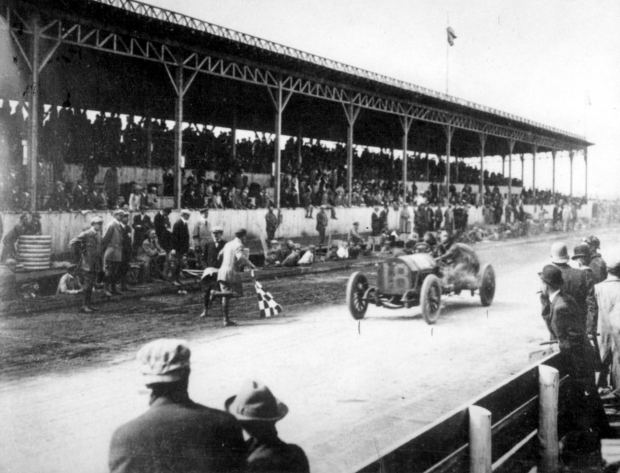Article “The 1910 Vanderbilt Cup Race” by Peter Helck

For the 1948 Veteran Motor Club of America Antique Auto Show, prominent artist Peter Helck, then owner of "Old 16", wrote an article on the Vanderbilt Cup Races for the official program. Supplemented by photos from the book "Vanderbilt Cup Races of Long Island", this is Helck's colorful description of the 1910 race:
The 1910 Vanderbilt Cup Race by Peter Helck
Reprinted from Program for the Antique Auto Show-Veteran Motor Club of America, March 8-14, 1948
.jpg) By 1909 the vogue of Stock-Chassis racing had become widespread; the direct result of the practical demands engendered by the fast-growing acceptance of the automobile. The car, no longer a mere sensational symbol of speed, was becoming a utility. Indeed, Ford's "Universal Car", the model T, was not far distant. Motoring, in the restricted fashionable sense, was past, and automobiling for pleasure and for business loomed promisingly for the great general public. Thus the cars being designed for this huge potential market came to replace the specialized racing creation, and Stock-Car racing, on road and track, reflected the social trends as well as the business acumen of our way of life. The Vanderbilts of 1909 and 1910 were Stock-Car contests and the last of the great Cup Series on Long Island. The classic-phase passed from the Nassau County roads to Savannah where the lingering "old-school exponents" race the pure thorobreds for America's Grand Prize. Furthermore, to insure opportunity for all, these last Cup Races were supplemented with minor contests for the smaller machines and in all classifications there were strict limitations of engine size. It is doubful if Mr. Vanderbilt anticipated this turn of affairs when deeding the Cup five short years before.
By 1909 the vogue of Stock-Chassis racing had become widespread; the direct result of the practical demands engendered by the fast-growing acceptance of the automobile. The car, no longer a mere sensational symbol of speed, was becoming a utility. Indeed, Ford's "Universal Car", the model T, was not far distant. Motoring, in the restricted fashionable sense, was past, and automobiling for pleasure and for business loomed promisingly for the great general public. Thus the cars being designed for this huge potential market came to replace the specialized racing creation, and Stock-Car racing, on road and track, reflected the social trends as well as the business acumen of our way of life. The Vanderbilts of 1909 and 1910 were Stock-Car contests and the last of the great Cup Series on Long Island. The classic-phase passed from the Nassau County roads to Savannah where the lingering "old-school exponents" race the pure thorobreds for America's Grand Prize. Furthermore, to insure opportunity for all, these last Cup Races were supplemented with minor contests for the smaller machines and in all classifications there were strict limitations of engine size. It is doubful if Mr. Vanderbilt anticipated this turn of affairs when deeding the Cup five short years before.
.jpg) To one man went the honor of winning the 1909 and 1910 Vanderbilts. He was Harry Grant, a big solid chap, and tester for Alco. Unemotional and steady, never swayed by the speed extravagances of his rivals, his Cup victories were the result of sticking resolutely to schedules which in his judgment were destined for success.
To one man went the honor of winning the 1909 and 1910 Vanderbilts. He was Harry Grant, a big solid chap, and tester for Alco. Unemotional and steady, never swayed by the speed extravagances of his rivals, his Cup victories were the result of sticking resolutely to schedules which in his judgment were destined for success.
.jpg) Grant's second grip on the Cup a year later follwed identical pattern. This time the largest field in Vanderbilt history; 26 U.S. cars, and four from Germany raced thru lanes of humanity numbering 300,000. Thirteen more cars in other categories cluttered the 12 1/2 mile circuit.
Grant's second grip on the Cup a year later follwed identical pattern. This time the largest field in Vanderbilt history; 26 U.S. cars, and four from Germany raced thru lanes of humanity numbering 300,000. Thirteen more cars in other categories cluttered the 12 1/2 mile circuit.
.jpg)
.jpg) Grant's stoicism prevailed. One again he maintained "railroad time"; ignoring the impetuous runaway of Chevrolet's Marquette-Buick, and the later dominanceof the clever Indianapolis duo, Dawson (Marmon) and Aitken (National).
Grant's stoicism prevailed. One again he maintained "railroad time"; ignoring the impetuous runaway of Chevrolet's Marquette-Buick, and the later dominanceof the clever Indianapolis duo, Dawson (Marmon) and Aitken (National).
.jpg) Fifty miles from the end, with Dawson's enforced four minute stop, the same low-hung Alco 60 swung into the lead. Dawson's slashing assault to catch Grant failed by 25 seconds.
Fifty miles from the end, with Dawson's enforced four minute stop, the same low-hung Alco 60 swung into the lead. Dawson's slashing assault to catch Grant failed by 25 seconds.
-1.jpg) It is significant that Grant's first inquiry after winning was, "What was my time?". Grant's time was 65.1 mph average; truly remarkable in view of the circuit jammed with competitors and the idiotic populace.
It is significant that Grant's first inquiry after winning was, "What was my time?". Grant's time was 65.1 mph average; truly remarkable in view of the circuit jammed with competitors and the idiotic populace.
.jpg) Due largely to the latter there were fatalities, and the old hue and cry was resumed- this time with conclusive results. The "bloody Vanderbilt" was Long Island's last. The Cup now went on tour.
Due largely to the latter there were fatalities, and the old hue and cry was resumed- this time with conclusive results. The "bloody Vanderbilt" was Long Island's last. The Cup now went on tour.
Links to related posts on VanderbiltCupRaces.com:
Archives: 1910 Vanderbilt Cup Race
A Tribute to Peter Helck (1893-1988), the Great American Artist

Comments